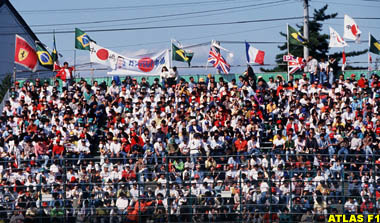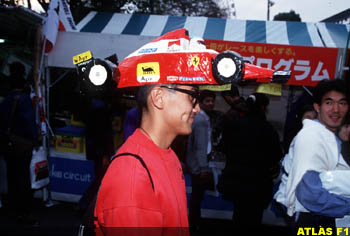Perhaps one of the most surprising things about a Japanese Grand Prix is the behaviour of the fans. It is a constant culture shock, as far as Europeans are concerned. A visit to the Japanese Grand Prix at Suzuka is like no other on the Formula One calendar.
 So as drivers, teams, mechanics and journalists settle into their varying sized hotels at and around Suzuka - large and comfortable for the drivers, small and cramped for the rest - what will they find? So as drivers, teams, mechanics and journalists settle into their varying sized hotels at and around Suzuka - large and comfortable for the drivers, small and cramped for the rest - what will they find?
First of all, while the Japanese fans are still passionate about Formula One, the interest has perhaps waned slightly over the last few years. The Japanese are quite fickle about their sports. For instance, the stories of Grand Prix tickets being over-subscribed five times is one that has passed into history. There are one or two - not many, admittedly - spare seats these days. Since those heady, early days, Japanese sports fans have enjoyed a brief fling with football.
However, there were several very impressive sights in the past. It was always remarkable, for instance, to arrive at the circuit for pre-qualifying on a Friday morning when it was still almost dark and there, in the gloom, were many thousands of spectators, already in their seats ready for the start of action at 8.00 am.
Later in the weekend, leaving the circuit at six or seven on Saturday evening, Europeans would not only be shocked to see that there were still people in the grandstands, staring across the deserted track to the lights in the garages, but even more so by a long column of people, seated on the ground outside the circuit between yellow lines about two meters wide. They had blankets, flasks of drink, food, torches and candles. They were clearly there for the night. They were queuing to get into the circuit when the gates opened early next morning.
 Such is the devotion of the Japanese fan. And he is served by a huge back-up industry. Nowhere in the world is the merchandising area as comprehensive as it is outside the gates of the Suzuka circuit, in the grounds of the Suzuka funfair. Any T-shirt that is available world-wide is available there. Team clothing, that of sponsors, even driver fan clubs, the tyre suppliers and other team partners may be purchased, much of it never seen at any other circuit around the world. Such is the devotion of the Japanese fan. And he is served by a huge back-up industry. Nowhere in the world is the merchandising area as comprehensive as it is outside the gates of the Suzuka circuit, in the grounds of the Suzuka funfair. Any T-shirt that is available world-wide is available there. Team clothing, that of sponsors, even driver fan clubs, the tyre suppliers and other team partners may be purchased, much of it never seen at any other circuit around the world.
And once bought, then itís just a short walk to the circuit itself. And a trip around the spectator enclosures reveals extraordinary dedication to the sport. Face painting, any kind of apparel, the flags of teams and even countries are waved with enthusiasm. Ninety-nine per cent of the fans are Japanese, but above them they will wave the flags of any of the participating countries that they support. Theyíre not the slightest bit partisan, not like the Italians or the Germans for instance with their Ferrari flags, or the British with their Damon Hill flags and hats. Why is this?
Japanese Formula One journalist, Kunio Shibata of the magazine GPX explains. "First of all, Japanese Formula One fans see Formula One as something very universal, very international. Furthermore, when it first came to Suzuka, there were no Japanese drivers, no Japanese engines, nothing, so to some extent, they were a little bit obliged to support the British and European drivers.
"But even after Japanese drivers and engines had become involved in Formula One, the sport was still seen as something exotic for Japanese fans so they still continued to support the foreigners.
 "Personally, I wouldn't get involved in face painting and that kind of thing, but for Japanese fans, itís not nationalism, the national flags that they wave arenít national flags for them, they are just symbols of Formula One in general and they represent the drivers they support. Itís part of Formula Oneís style - because Formula One is stylish." "Personally, I wouldn't get involved in face painting and that kind of thing, but for Japanese fans, itís not nationalism, the national flags that they wave arenít national flags for them, they are just symbols of Formula One in general and they represent the drivers they support. Itís part of Formula Oneís style - because Formula One is stylish."
So who will they be supporting in the forthcoming Japanese showdown? Shibata says that Hakkinen has always been popular but now less so. "Since the beginning of this year his popularity has been going down, because heís winning. They like to support the underdog. Heís a little bit a symbol of tragedy, a kind of heroism. So if heís too strong, itís not so interesting for them - and he drives a McLaren."
Ah, but so did Ayrton Senna, and heís still immensely respected in Japan. Shibata explains. "Senna didnít need a car, he was himself. His mentality was very close to the Japanese mentality. Hakkinen used to be the most popular driver, but Senna is still very very popular - probably the most popular driver in Japan.
"There are no real heroes for the Japanese among the current drivers. Itís a Japanese problem. Eddie Irvine is quite popular, sometimes heís more popular than Schumacher. People know him well because he spent quite some racing here and they like him."
For Irvine, that popularity is very important to him. After all, Ireland isnít very big, so after three years racing in Japan, to have attracted the kind of following that he has in that country is very important. "I have a great affection for Japan and the Japanese, and they seem to feel the same way about me," says the Scuderia Ferrari Marlboro driver.
"I still enjoy going back there and have a lot of friends to visit. Suzuka is special too. Iíve done a lot of racing there and even more tyre testing; itís like a second home to me, the best circuit in the world. And the fans are incredibly dedicated and loyal. They really know their drivers; theyíre very knowledgeable."
So itís against this backdrop that the final showdown of the 1998 World Championship takes place. Theyíve seen it all before, of course; because of their place in the calendar, the Japanese fans have seen the championship settled seven times before, and often acrimoniously. But nowhere in the world could Formula One have such a massive and enthusiastic crowd as a backdrop. Once again, they will see history made.
|